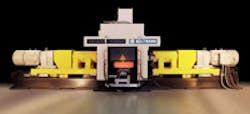New Billet-Heating Technology
Heating equipment is essential to forging for the same reason it is essential in the operations of extruders, rolling mills, and other metal producing operations — it’s necessary for raising the forging stock to working temperature before it enters into the forming equipment.
Superconductor technology
Zenergy Power Inc. (www.zenergypower.com), the U.S. operating unit for a developer of commercial products based on high-temperature superconductor (HTS) technology, reports it has been contracted to deliver an inductionheating system that employs powerful, energy-efficient magnets to preheat metal used in manufacturing electrical and structural parts for a wide range of industries.
In the coming installation, aluminum billets will be heated using electromagnets, before being extruded into predetermined shapes for automotive, building and construction, electrical, electronic, and refrigeration/air conditioning applications.
“By taking advantage of the unique properties of hightemperature superconductors, we’ve engineered a highly energy-efficient means of heating metal billets,” claims Dr. Larry Masur, Zenergy’s vice president of business development. “HTS materials conduct electricity with little or no electrical resistance, and they carry more than 100 times the current of copper wires the same size. These abilities enable magnets made of HTS wires to be far more effective at heating metal billets than conventional induction heaters.”
A study to be published next month shows the HTS induction heater achieves a heating efficiency of greater than 80%, compared to 50% for conventional equipment. Better energy utilization by the newer machines means they are less expensive to operate, while their more uniform heating of billets delivers higher quality and throughput for greater productivity. (The findings will be presented at ET ’08 Expo, a quadrennial conference for aluminum extrusion technology. )
This is the second HTS system sold for such an application. Last September, Zenergy announced that it had sold the world‘s first HTS induction heater to Germany’s Weser Alu GmbH. Weser Alu chose the design to improve the performance and efficiency for its industrial heating of aluminium billets, and the group reportedly expects to increase its productivity, improve overall economic efficiency of its industrial processes, and reduce its annual carbon footprint.
By adopting the Zenergy HTS components, the induction heater is said to be capable of delivering significant reductions in energy consumption to the metals industry with consequent savings in associated operating costs and reduction in carbon emissions. From the economic and environmental perspectives, these energy savings are particular noteworthy when it is considered that 1-5% of total annual electricity consumed in any industrialized country is directly attributable to the operation of electrical heating equipment for metal producing.
The discovery of superconductivity was a 20th century scientific breakthrough. The first superconductors, discovered in 1911, were called low-temperature superconductors, and these systems must be cooled to around 4 K (-269°C) — which makes them prohibitively expensive to operate in commercial energy applications.
High Temperature Superconductors (HTS) were discovered in 1986, and have no electrical resistance when cooled to 77 K, the temperature of liquid nitrogen, a very inexpensive, safe, common and easy to use cryogen. HTS also can be cooled without a liquid gas, by conduction cooling, making operation even simpler.
The advantages of HTS are undisputed. The materials deliver 100 times the power density of copper, practically without electrical resistance. This yields HTS machines significantly lighter and more compact, efficient, and economical than products that use copper wire. Moreover, these attributes are enabling applications that simply are not feasible with conventional copper wire.
Some features of Zenergy’s HTS induction heaters are:
- More than 90% system efficiency, effectively doubling the conventional efficiency;
- Faster heating process, thus increased productivity;
- Much smaller footprint;
- Capability of individual heating;
- Reduced material losses during production breaks;
- No need for auxiliary cooling;
- Significant reduction in carbon emissions;
- Full variation of the frequency, thus allowing for optimum radial temperature homogeneity; and,
- Defined axial temperature gradients, thus allowing for tapered temperature profiles.
Oxy-fuel rotary-hearth furnace
Ovako’s Hofors Works in Sweden has awarded Linde a contract to install a new rotary-hearth furnace for reheating billets. The furnace will be equipped with a Rebox flameless oxy-fuel system. This will be the third oxy-fuel fired furnace in Hofors; the earlier installations were made in 1997 and 1998, and later upgraded to flameless oxy-fuel operation. Ovako is a specialty steel long-products producer that supplies 2 million metric tons/year of low-alloy and carbon steel to bearing, heavy vehicle, automotive and engineering industries.
The first installation of oxy-fuel in a reheat furnace at Ovako was made by Linde 13 years ago. Since then the majority of the furnaces at Hofors have been converted to all oxy-fuel operation. In general, the results have been a 35% increase in heating capacity and 35% decrease in fuel consumption. Rebox flameless oxy-fuel operation also lowers NOX emissions and improves high temperature uniformity.
The new rotary-hearth furnace will be an important part of Ovako’s production of material for the growing windmill market. Linde will deliver a turnkey installation project, including guaranteed capacity, emission levels, and quality. Commissioning is scheduled for February 2009. The advantage of oxy-fuel is based on the fact that if oxygen is used to combust a fuel, instead of air, all the heat-transfer mechanisms — convection, conduction, and radiation — can be promoted at the same time. This results in a faster and more even heating process, which cuts the total heating time, thus allowing for more production capacity and flexibility. The flue-gas volumes are reduced by up to 80% with no more need for bulky flue-gas systems or recuperators.
Rebox oxy-fuel solutions are employed in over 110 reheat and annealing furnaces. The use of oxy-fuel will further improve important parameters such as fuel consumption, throughput capacity, and emission levels. Compared to airfuel solutions, oxy-fuel can boost production throughput up to 50%, equally reducing fuel consumption and CO2 emission by 50%.
